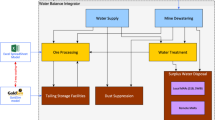Abstract
There have been many management science models proposed for optimizing various operational aspects of municipal water systems. However, our practical experience indicates that water managers view such modeling attempts with skepticism. Too much effort has been spent on developing elegant, complex models, instead of focusing on providing water managers with systems that support their total information needs. This paper presents the design and development of the Water Resource Management System (WREMS). The main distinction of the WREMS system is that the optimization model used to offer operational guidance is imbedded within an inventory data management information system, the "hook" that interests the city water managers in trusting and, ultimately, using the system. The optimization model incorporated within WREMS is a customized network simplex imple-mentation of a minimum cost network flow problem, designed to assist in making daily decisions such as which wells to produce and how to manage water levels in reservoirs. Details of the linkages between the data management and optimization components of the system are highlighted, illustrating how IS and MS/OR can be synergistically coupled.
Similar content being viewed by others
References
F. Fallside and P. Perry, Hierarchical optimization of a water-supply network, Proceedings IEE 122(1975)202–208.
S. Gorelick, A review of distributed parameter groundwater management modeling methods, Water Resources Research 19(1983)305–319.
Y. Hsu and C. Yang, Design of artificial neural networks for short-term load forecasting, Proceedings IEEE 138(1991)407–418.
P. Jensen and J. Barnes, Network Flow Programming, Wiley, New York, 1980.
M. McDonald and A. Harbaugh, A modular three-dimensional finite-difference ground water flow model, U.S. Geological Survey, 1984.
L. Ormsbee and K. Lansey, Optimal control of water supply pumping systems, Journal of Water Resources Planning and Management 120(1994)237–252.
B. Reely, A linked optimization-simulation aquifer management model, unpublished Ph.D. Dissertation, Oklahoma State University, 1992.
B. Reely and R. Wilson, Using optimization in municipal aquifer management: A feasibility study, Proceedings Annual Meeting of the Decision Sciences Institute, 1992.
A. Tarquin and J. Dowdy, Optimal pump operation in water distribution, Journal of Hydrology Engineering 115(1989)158–168.
R. Wilson and B. Reely, Implementation of water distribution management system: A case study and lessons learned, Working Paper, Oklahoma State University, 1995.
Rights and permissions
About this article
Cite this article
Wilson, R.L., Reely, B.T. & Cox, M. The Water Resource Management System (WREMS): Linking data management and operational optimization. Annals of Operations Research 72, 105–124 (1997). https://doi.org/10.1023/A:1018940103278
Issue Date:
DOI: https://doi.org/10.1023/A:1018940103278




